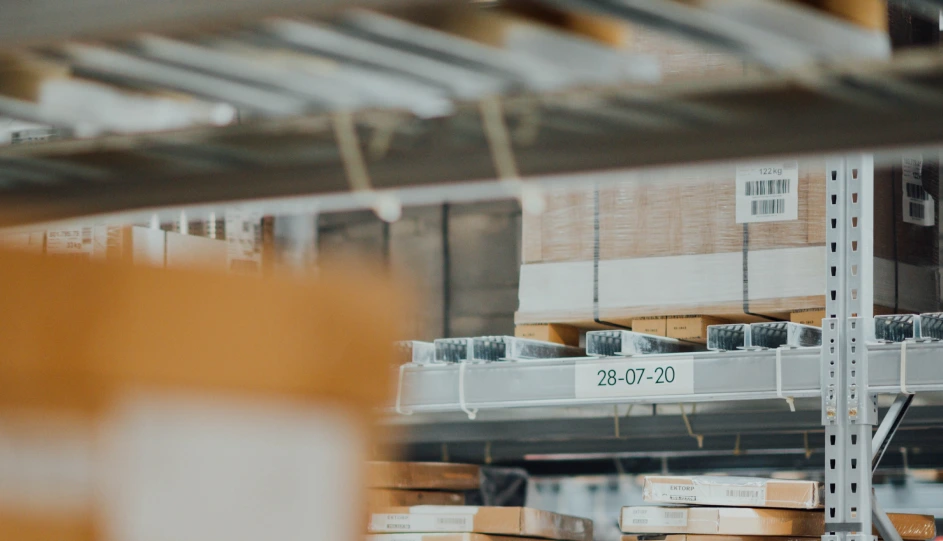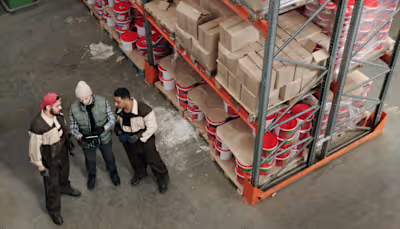2,500-word blog for Hive: What is pick and pack?

Pick and pack is a warehousing method used for successful order fulfillment. The pick and pack process has four key steps, and gives logistics operators complete control over order fulfillment. Pick and pack fulfillment ensures that orders are fulfilled correctly, cost-effectively and in the shortest time possible. E-commerce companies can benefit from total flexibility using the pick and pack method.
Pick and pack fulfillment in e-commerce
E-commerce customers expect to receive their orders faster than ever before, so dispatch speed gives you a competitive advantage. Pick and pack processes are a necessity because they enable e-commerce businesses to meet increasing customer demand while keeping track of inventory.
Managing inventory is arguably the most crucial part of the pick and pack process. There is an art and science to successful pick and pack systems, and that includes good inventory management. Technology is also a key aspect. The right pick and pack software helps e-commerce businesses to ship orders with maximum speed and total accuracy.
Working with a 3PL provider will help you manage your inventory. A 3PL service will organize the shelving and storage of your inventory across their network of warehouse and fulfillment centers. 3PL companies will take into account the size and number of products to ensure that your inventory is easily accessible for pickers and packers.
Partnering with a 3PL to manage pick and pack processes is a far more time- and cost-efficient alternative than trying to handle it in-house. 3PL services already have the infrastructure and warehouse strategies in place to support your e-commerce company's entire pick and pack requirements.
Find out more about what 3PL means here.

What is pick and pack fulfillment?
Pick and pack fulfillment is the physical process of picking stock off warehouse shelves and then packaging them to fulfill customer orders that have been received - usually via an Order Management System (OMS).
Most e-commerce companies outsource their pick and pack fulfillment needs because they need specialist support with the actual picking and packing of products, order processing, inventory management and storage. Plus, outsourcing pick and pack requirements enables e-commerce businesses to scale quicker and more flexibly.
What is the pick and pack process?
The pick and pack process features four key stages:
1. Order receiving
Step one of the pick and pack process is receiving inventory from the producer or supplier of a product. Once inventory has been transported to a warehouse, the following tasks are then performed:
An item check to ensure that the correct number of products has been received and matches warehouse records
Checks for damage or spoilage
Location and quantity tracking by adding SKUs to a warehouse management system
Ensuring all items have barcodes labels or SKU codes attached
By using a 3PL provider, all of these tasks would be taken care of.
If you are using software, your e-commerce sales channels should integrate with warehouse systems. Then, when a customer places an order, the software at a fulfillment center will automatically generate information which shows the warehouse picker what and where the order is.
2. Order picking
Warehouse pickers and packers use this information to locate items and pick them from the shelves. Order picking and inventory storage are key to your pick and pack service as they will determine how efficient your order fulfillment process is. Different picking methods will work best for different e-commerce companies depending on the volume of sales.
3. Order packing
Once an order has been picked and checked, it then goes to a packing station where it is securely packed, sealed and labeled ready for shipping.
4. Order shipping
After an order is packed, orders are then sorted by carriers on the loading dock. Packages are often weighed, and a decision is made on the best way to transport packages. They are then prepared for collection ready for the next leg of their journey.
During transit, carriers will often keep vendors and customers notified about the status of an order, so that everyone knows when ordered items will be delivered.

Pick and pack methods - top four warehouse picking strategies
There are four primary pick and pack methods that e-commerce businesses could utilize to ensure successful order fulfillment. Your pick and pack methods may change as you grow and scale-up your company. The right pick and pack solution can help to reduce mistakes, cut costs and delight your customers.
The four pick and pack methods are:
1. Piece/discrete picking
The piece pick and pack method - sometimes referred to as discrete picking - involves picking and packing one order at a time. Essentially, you take the packing slip of one order and items are picked off the shelves around the warehouse. Once items have been gathered, they are taken to a packing station ready for packaging.
Piece picking is where most e-commerce companies tend to start before they grow. If you are a small e-commerce business with a few orders a day, piece picking may be the most convenient pick and pack method to use.
Some warehouses utilize piece picking robot technology to make their pick and pack process more efficient. According to Digital Journal, the piece picking robot market is expected to reach more than $430 million by 2027.
2. Batch picking
If you are an e-commerce company that receives enough orders to organize them into batches, then batch picking could be ideal for your business. Batch picking tends to be reserved for picking and packing items that are in the same warehouse location. The aim of batch picking is to give pickers and packers the most efficient route around the warehouse.
If one SKU is required for several orders, then logically those orders should all be picked together. This saves time on pickers and packers walking back and forth, meaning orders will be dispatched faster.
Batch picking can be utilized even if your e-commerce business is small. You could consider picking all of your orders at a set time each day. This will prove to be a more efficient method than picking and packing each and every order as it is received. By picking orders all at once, they can be batched.
A number of pick and pack software solutions exist to help e-commerce businesses batch orders for picking and packing.

3. Zonal picking
If your inventory is stored in a large fulfillment warehouse, zone picking is a good technique for picking and packing orders. Zonal picking involves pickers and packers sticking to a specific warehouse zone and only picking the products located in their designated area.
Once a picker and packer has collected all items from their location, they transfer the order to a warehouse worker in the next zone. After the order has moved through all the zones, it then goes to the packing station.
Coordination is key to making zonal picking work. Warehouse management software is a necessity for managing zone picking techniques.
4. Wave picking
Wave picking combines batch and zonal picking. Warehouse workers are deployed to pick items within a specific zone for a batch order and not just a single order. Batches are then transferred to the next zone ready for the next round of picking.
Order picking best practices
Every pick and pack method relies on coordination, organization and strong inventory management. They form the foundation of order picking best practices. To help facilitate successful picking and packing, the use of technology to automate processes is rising rapidly.
If you are managing your own pick and pack processes, you should do the following to ensure that your operation runs smoothly and successfully:
Integrate warehouse management software (WMS)
Integrating a warehouse management software solution can help to support your warehouse staff, making their job easier and more efficient - without hindering your order fulfillment accuracy.
The ideal WMS should be able to auto-generate picking lists, display product availability accurately, provide real-time insights into the status of an order, help to forecast when stock levels need replenishing via reorder point notifications and even help to assist with planning labor requirements.
Choose the right warehouse tools and equipment
You will need to invest in the right tools and equipment that not only enhance your pick and pack fulfillment requirements, but maintain workplace safety. When selecting tools and equipment, you should consider how they will help to facilitate efficient movement across your warehouse space and whether they accelerate automation.
It is best practice to be continually improving the warehouse picking process. From forklift trucks moving large containers and stacking warehouse racks to conveyor systems for sorting parcels, and barcode and inventory scanners for improving tracking, there is always something that can be improved.
Think about warehouse optimization
There should be a specific focus on the flow of your warehouse facility. Ideally you want to optimize your space based on the order in which inventory travels through each functional area. Every area should logically lead to the next, which would eliminate the need for doubling back or passing through a later process on the way to an earlier one.
With so many stages of the order fulfillment process happening all at once, you will need to be constantly improving your warehouse layout to ensure the most efficient picking routes, storage locations for each SKU and the transfer from picking to packing.
Always be monitoring warehouse productivity
The best way you can help your order pickers is to keep track of productivity across your warehouse. You should keep a close eye on distribution metrics such as:
Inventory turnover
Time to ship
Total units in storage
Average warehouse capacity used
Order picking accuracy
At regular intervals, there should be discussions on these metrics and how to improve upon each one.
Outsource to a 3PL provider
If you do not have capacity to manage order fulfillment, including picking and packing, outsourcing to a third-party logistics (3PL) provider is the best thing you can do. Outsourcing means that you don't have to worry about organizing warehouse space and the associated costs that come with it.
Outsourcing frees you to focus on more strategic objectives of your e-commerce business, such as product development and marketing.
What is pick and pack software?
The most successful order fulfillment systems utilize pick and pack software. Historically, the warehouse picking process has been expensive because it is highly labor intensive, especially in larger fulfillment centers and warehouses.
Pick and pack software helps to cut costs by reducing the amount of manual labor involved in warehouse processes. Plus, software helps to improve productivity by optimizing warehouse systems. Pick and pack software is designed to keep track of all customer orders and auto-generate picking lists to support warehouse picking and packing staff.
Where some systems might require you to upload orders manually, easy to integrate pick and pack software ensures that customer orders are automatically issued to fulfillment centers. As soon as an order is received, the picking process can begin immediately - no delays - and picking teams have everything they need to assemble orders quickly and efficiently.
For the packing process, some pick and pack software is so intricate that it can help to select the right boxes in which items should be packed, based on dimensions and packing preferences. This is extremely useful for ensuring consistent fulfillment pricing.
Some pick and pack software solutions are free to use, but you don't often get as many features. To unlock the full features of pick and pack software you will likely have to pay a monthly fee. You can compare product reviews and pricing online to find the right solution to suit the needs of your e-commerce company.
Benefits of pick and pack fulfillment for e-commerce sellers
There are many benefits of pick and pack fulfillment for e-commerce sellers. Here is the 'pick' of the bunch:
1. Improved customer service
Delighting the customer is the main objective of e-commerce companies - good customer service keeps them coming back, building loyalty toward your brand. The right pick and pack fulfillment strategy enhances customer service and satisfaction levels.
You can easily control the movement of inventory and expedite order fulfillment for fast delivery and total visibility of customer orders. According to a recent DispatchTrack report, 90% of customers now prioritize the ability to track their order over delivery speed.
However, the same report also revealed that 60% of e-commerce shoppers would abandon a business if deliveries don't arrive within the scheduled window. The right pick and pack method will ensure on-time deliveries.
2. Boosting efficiency
The right approach to picking and packing saves time while speeding up your entire order fulfillment process. Goods can be efficiently inventoried, stored, picked and packed in one location.
If all fulfillment activities happen under one roof, it removes the tedious process of trying to assemble orders from various storage facilities or sending items to another location for labeling.
3. Highly cost-effective
Pick and pack processes are an extremely cost-effective part of order fulfillment strategies, helping to minimize overall operational costs. Technology has been a key driver in helping to keep pick and pack costs down by reducing the amount of staff labor required.
Pick and pack software in particular has helped to reduce order mispicks by providing accurate pick lists for warehouse workers to work from. This has helped to reduce the cost of returns handling and more.
Ultimately, pick and pack gives logistics operators complete control over the order fulfillment process. Such control allows for the entire process to be streamlined for the purpose of accurately fulfilling orders, reducing costs and speeding up delivery times.
How to choose a pick and pack fulfillment partner?
Choosing the right pick and pack fulfillment partner for your e-commerce company can be done successfully when considering the following factors:
Services provided
What services does the pick and pack partner provide? Do they line up with the needs of your business? As a minimum, they should provide the basic pick, pack and shipping capabilities, but you might need more depending on the size of your business and the products you are selling.
Do you need to ship different items in a specific way? Does the service handle returns for you? These are just some of the questions you will need to consider. You will need to identify what your specific needs are and then decide whether a potential pick and pack partner can provide those services.
Pricing terms
Good pricing terms for your requirements are a necessity for keeping your costs down and to ensure you are getting value for money. If you plan to use a 3PL provider, you will need to think about warehouse storage fees.
Most pick and pack services tend to charge based on inventory storage, package size and weight, order handling and shipping locations. You will need to do your research and compare companies to find the right price point for you.
Systems integration
Ideally, you want to work with a pick and pack partner that can integrate with your e-commerce systems to help streamline all of your business processes. You will certainly want to integrate your fulfillment data and inventory management systems.
However, if you plan to use a 3PL service, it's likely that they will integrate with your systems to ensure a fully-managed service.
The factors behind choosing a pick and pack service for your e-commerce operation is not exhaustive. Ultimately, you will have to decide which service is the right fit for your business, but choose a solution that gives you the support you need.
E-commerce order fulfillment with Hive
Hive offers a best in class, all in one fulfillment solution with seamless integration, dedicated reporting, forecasting and tracking, all through the Hive app. Connect your shop software to the app in minutes and manage your orders, restocking, packaging, freight and more.
Like this project
Posted Aug 18, 2023
A 2,500-word, ghost written SEO blog for Hive.app, covering what pick and pack means, the different methods, and best practices.








